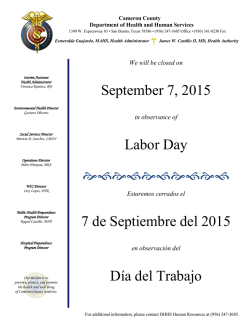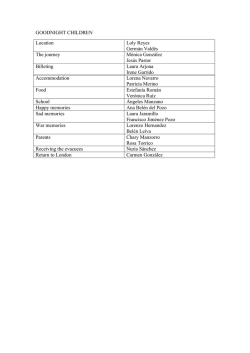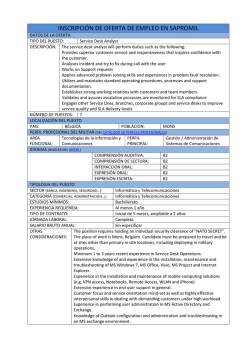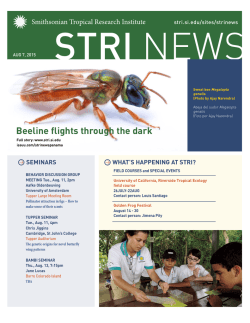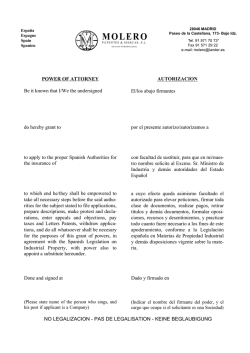
MonTI 7 (2015) - ISSN: 1889-4178 Legal Interpreting at a Turning
María Jesús Blasco Mayor & Maribel del Pozo Triviño (eds.) Legal Interpreting at a Turning Point / La interpretación judicial en un momento de cambio MonTI 7 (2015) - http://dti.ua.es/es/monti-english/monti-contact.html MonTI 7 (2015) - ISSN: 1889-4178 María Jesús Blasco Mayor & Maribel del Pozo Triviño (eds.) Legal Interpreting at a Turning Point La interpretación judicial en un momento de cambio Table of contents and abstracts / Índice y resúmenes Inhaltsverzeichnis und Zusammenfassungen Table des matières et résumés Index i resums María Jesús Blasco Mayor & Maribel del Pozo Triviño (eds.) Legal Interpreting at a Turning Point / La interpretación judicial en un momento de cambio MonTI 7 (2015) - http://dti.ua.es/es/monti-english/monti-contact.html 1. Blasco Mayor, María Jesús & Maribel del Pozo Triviño. (2015) “Legal Interpreting in Spain at a Turning Point” / “La interpretación judicial en España en un momento de cambio” - MonTI 7 (2015), pp. 9-71. [Available in English and Spanish]. Spanish version – Blasco Mayor, María Jesús & Maribel del Pozo Triviño. (2015) “La interpretación judicial en España en un momento de cambio.” In: Blasco Mayor, María Jesús & Maribel del Pozo Triviño (eds.) Legal Interpreting at a Turning Point - MonTI 7 (2015), pp. 9-40. DOI: http://dx.doi.org/10.6035/MonTI.2015.7.1 La publicación en la Unión Europea de la Directiva 2010/64/UE del Parlamento Europeo y del Consejo, de 20 de octubre, relativa al derecho a interpretación y traducción en los procesos penales ha marcado un antes y un después en una gran cantidad de aspectos relacionados con la interpretación en sede judicial y policial. Esta norma tiene como principal objetivo garantizar la interpretación judicial de calidad durante todo el proceso, como parte del derecho a la defensa y a un juicio justo. España, como Estado Miembro de la UE, tiene la obligación de transponer la norma europea a su derecho interno. Se trata, pues, de un momento histórico en el que confluyen dos factores principales: la necesidad de cambiar la legislación para adaptarla a la nueva norma y la necesidad de implementar medidas para garantizar el cumplimiento de los nuevos mandatos. En el presente artículo se realiza una revisión del estado de la cuestión sobre la interpretación judicial en España desde el punto de vista de la legislación y de la provisión de servicios, y se analizan las medidas que debe tomar nuestro país para garantizar que la interpretación en los tribunales de justicia se lleva a cabo con las debidas garantías. Estas medidas incluyen la formación de intérpretes y de operadores judiciales, la creación de sistemas de acreditación y registros, así como la consolidación del perfil profesional de los intérpretes. English version – Pozo Triviño, Maribel & María Jesús Blasco Mayor. (2015) “La interpretación judicial en España en un momento de cambio.” In: Blasco Mayor, María Jesús & Maribel del Pozo Triviño (eds.) Legal Interpreting at a Turning Point - MonTI 7 (2015), pp. 41-71. DOI: http://dx.doi.org/10.6035/MonTI.2015.7.1 The publication in the European Union of Directive 2010/64/EU of the European Parliament and of the Council of 20 October 2010 on the right to interpretation and translation in criminal proceedings has been a turning point in a great number of aspects related to court and police interpretation. The main objective of the Directive is to ensure quality legal interpretation throughout the process, as part of the right to defence and to a fair trial. Spain, as a Member State of the EU, has the obligation to transpose this European Directive into its domestic law. Therefore, this is a historic moment in which two main factors converge: the need to change the legislation to bring it in line with the new Directive and the need to implement measures to ensure compliance with new mandates. This paper reviews the present state of legal interpretation in Spain from the point of view of legislation and that of service provision and analyses the measures that Spain should take to ensure that court and police interpretations are carried out with due guarantees. These measures include the training of interpreters and legal operators, the creation of accreditation systems and records, as well as the consolidation of the professional profile of interpreters. 2. Hertog, Erik. (2015) “Directive 2010/64/EU of the European Parliament and of the Council on the Right to Interpretation and Translation in Criminal Proceedings: Transposition Strategies with Regard to Interpretation and Translation in Criminal Proceedings”. In: Blasco Mayor, María Jesús & Maribel del Pozo Triviño (eds.) Legal Interpreting at a Turning Point - MonTI 7 (2015), pp. 73-100. DOI: http://dx.doi.org/10.6035/MonTI.2015.7.2 [Available in English] It is difficult to overestimate the importance of Directive 2010/64/EU on the right to interpretation and translation in criminal proceedings. It is the first directive under the Lisbon Treaty, the first directive in the field of Justice (up till then one had recourse to framework decisions only), the first directive on language since the founding treaties of the EU and, of course, the first directive on issues of translation and interpretation. In this contribution we will discuss the relevant policy-making history leading up to the Directive, highlight the main challenges the Directive presents to the Member States that need to transpose this binding Directive into their own legislation and practice and, finally, suggest a number of strategies and policies that could help the transposition process, both in the short and long term. María Jesús Blasco Mayor & Maribel del Pozo Triviño (eds.) Legal Interpreting at a Turning Point / La interpretación judicial en un momento de cambio MonTI 7 (2015) - http://dti.ua.es/es/monti-english/monti-contact.html 3. Corsellis, Ann. (2015) “Strategies for Progress: Looking for Firm Ground”. In: Blasco Mayor, María Jesús & Maribel del Pozo Triviño (eds.) Legal Interpreting at a Turning Point - MonTI 7 (2015), pp. 101114. DOI: http://dx.doi.org/10.6035/MonTI.2015.7.3 [Available in English] Over the last thirty years, there have been various and increasing efforts made to establish effective and consistent public service interpreting and translation. Good progress has been made but there are impasses. This paper attempts to stand back and look objectively at where, and more importantly how, we might proceed from here. This could be said to be a turning point for legal interpreting for two reasons. Firstly, enough time has elapsed for us to copy our scientific colleagues, who view the process of exploring and eliminating unsatisfactory approaches overtly, so that what does not work is recognised and discarded. Secondly, this process of exploration has enabled us to clarify and define what does work in order to focus our energies and take matters forward. 4. Wallace, Melissa. (2015) “Resisting Market Disorder and Ensuring Public Trust”. In: Blasco Mayor, María Jesús & Maribel del Pozo Triviño (eds.) Legal Interpreting at a Turning Point - MonTI 7 (2015), pp. 115-140. DOI: http://dx.doi.org/10.6035/MonTI.2015.7.4 [Available in English] This article aims to describe the current state of affairs as regards national registers of legal interpreters and translators (LITs) in the United States and the European Union. After a brief overview of what translation and interpreting studies researchers and EU work group participants recommend about their construction and utilization, a case will be made for the use of national registers as essential tools in two important struggles: professionalizing legal translation and interpreting and building public trust. Based on current models and recommendations by researchers, a proposal will be put forth for minimum characteristics of a national register of LITs. Rather than an afterthought, the interpreter register merits scrutiny and careful elaboration precisely because of an ever more ubiquitous need for states and countries to implement measures which are fair, transparent, cost-effective, which guarantee due process, and which provide users with ways to make an objective value judgment regarding the competence of the interpreters they commission. 5. Andjelic, Jasmina Tatar. (2015) “Interpretation judiciaire au Montenegro dans l’optique de l’adhesion europeenne: diagnostic et propositions des modifications indispensables” / “Legal interpreting in Montenegro in view of its EU accession: diagnosis and proposals of necessary modifications.” In: Blasco Mayor, María Jesús & Maribel del Pozo Triviño (eds.) Legal Interpreting at a Turning Point - MonTI 7 (2015), pp. 141-162. DOI: http://dx.doi.org/10.6035/MonTI.2015.7.5 [Available in French and in English] The aim of this paper is to analyze the current situation in the field of court interpreting in Montenegro, from both a normative and a practical point of view, in the light of future EU accession. Following the assertion that there is an increasing need for quality interpretation and the description of an ideal court interpreter, this paper presents the situation at the national level, relying upon the existing legislation in force. It is noted that Montenegrin legislation is generally harmonized with the EU Directive 2010/64/EU, but there is an issue of terminology that results in an unclear distinction between interpretation and translation. This paper proposes several solutions in order to define more detailed criteria for the selection of interpreters, form and content of the exam, necessity of organizing specialized training, introduction of a reliable system of quality control and establishment of a representative professional association. 6. Hale, Sandra. (2015). “Approaching the Bench: Teaching Magistrates and Judges how to Work Effectively with Interpreters.” In: Blasco Mayor, María Jesús & Maribel del Pozo Triviño (eds.) Legal Interpreting at a Turning Point MonTI 7 (2015), pp. 163-180. DOI: http://dx.doi.org/10.6035/MonTI.2015.7.6 [Available in English] Reports about judicial misunderstandings of the interpreting process are common (Berk-Seligson 2008; Morris 2010; Hale 2011a). The misconception that interpreters ‘just translate’ from one language to another by swapping individual words from language A to language B in a mechanical, uncomplicated way, is still prevalent among some legal professionals. Research into court interpreting, however, has highlighted the complexities involved in attempting to achieve a pragmatically accurate rendition in conditions that are usually less than adequate (Hale 2004; Mikkelson 2008; Hale & Stern 2011). In order for court interpreting to be successful, all parties must be aware of its challenges and share the responsibility for effective communication (Ozolins & Hale 2009). This chapter will describe the contents and structure of a workshop designed and delivered by the author to Australian magistrates, judges and tribunal members on how to work effectively with interpreters, for over ten years. It will further discuss the positive concrete outcomes achieved through the raising of awareness among the judiciary about the importance of interpreters in the legal system. María Jesús Blasco Mayor & Maribel del Pozo Triviño (eds.) Legal Interpreting at a Turning Point / La interpretación judicial en un momento de cambio MonTI 7 (2015) - http://dti.ua.es/es/monti-english/monti-contact.html 7. Angelelli, Claudia. (2015) “Justice for All? Issues Faced by Linguistic Minorities and Border Patrol Agents during Interpreted Arraignment Interviews”. In: Blasco Mayor, María Jesús & Maribel del Pozo Triviño (eds.) Legal Interpreting at a Turning Point - MonTI 7 (2015), pp. 181-205. DOI: http://dx.doi.org/10.6035/MonTI.2015.7.7 [Available in English]. The Tijuana (Mexico) - San Ysidro (San Diego County, CA) international border is the world’s busiest port of entry. The US Customs and Border Protection Agency hires over 60,000 employees, 21,000 of whom are agents in the US Border Patrol. Several steps must be taken to become a border patrol agent, but being bilingual is not a pre-requisite. In order to communicate with detainees, and interrogate them the US Border Patrol Agency hires the services of Telephone Interpreting Companies. In this study I present segments of a 2 hour and fifty minute transcript that captures a typical border patrol agent /detainee interaction facilitated by an ad-hoc interpreter. I examine the power differentials between the interlocutors and the role played by the telephone interpreter in mitigating or reinforcing such power. After analyzing the interpreter’s credentials and the border patrol linguistic needs, I specifically look at interpreter’s linguistic behaviors that lead to a detention reversed during the trial. This study calls into question the construct of justice when serving the needs of culturally and linguistically diverse populations. 8. Ortiz Soriano, Adela. (2015) “La imparcialidad en la interpretación policial” / “Impartiality in police interpreting.” In: Blasco Mayor, María Jesús & Maribel del Pozo Triviño (eds.) Legal Interpreting at a Turning Point - MonTI 7 (2015), pp. 207-241. DOI: http://dx.doi.org/10.6035/MonTI.2015.7.8 [Available in Spanish and in English]. The different codes of ethics applicable to interpreting in police settings include principles - confidentiality, fidelity, impartiality - that every interpreter should obey. The police setting, however, creates situations in which it is not possible to follow these principles. Taking this contradiction as a starting point, and focusing on the principle of impartiality, the aim of this study is to verify if there is, indeed, a divorce between theory and practice and to establish what determines the eventual divergence. In order to validate the hypothesis, the study describes five interpreting sessions between French and Spanish that took place at different police stations in Valencia. The data were collected by means of a questionnaire filled in by the interpreter-researcher. The results show that there is in fact a divorce between theory and practice and the analysis suggests the possible causes behind the tensions that the interpreter encounters when trying to keep the principle of impartiality in police interpreting. 9. Ng, Eva. (2015) “Teaching and Research on Legal Interpreting: A Hong Kong Perspective”. In: Blasco Mayor, María Jesús & Maribel del Pozo Triviño (eds.) Legal Interpreting at a Turning Point - MonTI 7 (2015), pp. 243-270. DOI: http://dx.doi.org/10.6035/MonTI.2015.7.9 [Available in English]. Court interpreters have long been a fixture in the bilingual Hong Kong courtroom, where English was once the only official court language and remains dominant to this day especially in the High Court, although litigants appearing in court as witnesses and defendants mostly speak Cantonese. The installation of the Digital Audio Recording and Transcription System (DARTS) in the courts from the mid-1990’s gave birth to a bilingual reporting system, which provides not only verification ensuring a better administration of justice, but also a valuable source of data for the teaching and research of legal interpreting. Based on the recorded court proceedings of nine interpreter-mediated trials in the Hong Kong courtroom, this paper discusses the benefits of using audio courtroom data for pedagogical and scholarly purposes. While the use of real courtroom data as training material helps enhance students’ learning experience, research findings of this data-driven study further shed light on the training needs for interpreter education in the legal setting. This paper investigates the Hong Kong courtroom as an atypical bilingual setting and in the light of the findings makes recommendations for best practice in the courtroom and for institutional and administrative practice. 10. Crezee, Ineke; Jo Anna Burn & Nidar Gailani. (2015) “Authentic Audiovisual Resources to Actualise Legal Interpreting Education”. In: Blasco Mayor, María Jesús & Maribel del Pozo Triviño (eds.) Legal Interpreting at a Turning Point MonTI 7 (2015), pp. 271-293. DOI: http://dx.doi.org/10.6035/MonTI.2015.7.10 [Available in English]. New Zealand Aotearoa is an English-medium country and a home to a high number of minority migrant groups speaking over 160 different languages. To cater to the needs of such a diverse population, the Interpreting and Translation Team at Auckland University of Technology has developed a language neutral pedagogy using a range of innovative teaching methods. One method is the use of authentic audio-visual material incorporating extracts from murder trials to raise awareness of courtroom discourse in general, and lawyers’ questions in particular. The aim of this study was to ascertain to what extent audiovisual clips are beneficial in legal interpreter education. After viewing audiovisual clips, students posted their practice on the university website. These recordings were then de-identified and formative feedback was given by language-specific markers as per standard performance based criteria. Students’ evaluation and comments from pre- and post-intervention surveys were analysed and form the basis of a discussion.
© Copyright 2024
